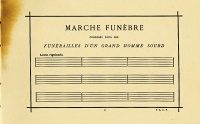Funeral March for the Obsequies of a Deaf Man
From The Art and Popular Culture Encyclopedia
(Difference between revisions)
| Revision as of 12:54, 11 April 2014 Jahsonic (Talk | contribs) ← Previous diff |
Revision as of 12:56, 11 April 2014 Jahsonic (Talk | contribs) Next diff → |
||
| Line 18: | Line 18: | ||
| * Sometimes the piece is said to consist of 24 empty bars. | * Sometimes the piece is said to consist of 24 empty bars. | ||
| ==See also== | ==See also== | ||
| + | *[[Deaf man]] | ||
| + | *[[Silent music]] | ||
| *[[Funeral march]] | *[[Funeral march]] | ||
| {{GFDL}} | {{GFDL}} | ||
| [[Category:WMC]] | [[Category:WMC]] | ||
Revision as of 12:56, 11 April 2014

Funeral March for the Obsequies of a Deaf Man (1884), a composition by Alphonse Allais. It consists of nine blank measures and predates comparable works by John Cage ("4′33″") by a considerable margin.
|
Related e |
|
Featured: |
"Marche Funèbre composée pour les Funérailles d'un grand homme sourd" (1884, English: "Funeral March for the Obsequies of a Deaf Man" or "Funeral March Composed for the Funeral of a Great Deaf Man") is a composition by Alphonse Allais. It consists of nine blank measures and predates comparable works by John Cage ("4′33″") and Erwin Schulhoff by a considerable margin.
Contents |
Publication and exhibition history
The work was first exhibited in the Salon des Incohérents (1884) under the title "Marche funèbre incohérente — les grandes douleurs sont muettes" but printed in Album Primo-Avrilesque[1] (1897) under the title "Marche Funèbre composée pour les Funérailles d'un grand homme sourd".
Preface
- L'AUTEUR de cette Marche funèbre s'est inspiré, dans sa composition, de ce principe, accepté par tout le monde, que les grandes douleurs sont muettes.
- Les grandes douleurs, étant muettes, les exécutants devront uniquement s'occuper à compter des mesures, au lieu de se livrer à ce tapage indécent qui retire tout caractère auguste aux meilleures obsèques.
- “The author of this funeral march was inspired in his composition by the principle, accepted by everyone, that great pain is silent.
- [And because] These great pains are silent, the performers must concern themselves solely with counting the measures, instead of indulging in that unseemly din which robs the best funerals of their noble character.”[2]
References
- Funeral March for the Last Rites of a Deaf Man, alternative translation of the title.
- Sometimes the piece is said to consist of 24 empty bars.
See also
Unless indicated otherwise, the text in this article is either based on Wikipedia article "Funeral March for the Obsequies of a Deaf Man" or another language Wikipedia page thereof used under the terms of the GNU Free Documentation License; or on research by Jahsonic and friends. See Art and Popular Culture's copyright notice.

